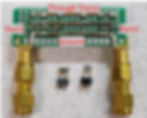Evaluating efficiency, transformer and mismatch losses in toroid transformers - some observations.
- Dan Koellen AI6XG
- Jun 17, 2022
- 6 min read
Updated: Nov 24, 2024
There are several posted evaluations of high frequency (HF) toroid transformer characteristics, especially for transformers for end fed half wave (EFHW) antennas. Either one transformer with a load or two transformers back to back have been used, with each configuration claiming to measure transformer efficiency. But what is transformer efficiency? Are the two methods equivalent? Here are a few observations and basic evaluation from my experiments.
Transformer plus load configuration
This configuration uses one transformer with a load resistor and a VNA to measure s parameters (Figure 1 left). A common case is an EFHW transformer with 1:7 turns ratio for an impedance ratio of 1:49 (primary:secondary). The load resistor (ZL) would then be 2400 Ohms for a total load of 2450 Ohms including the 50 Ohm VNA port 2 impedance. For this post, closely wound tapped transformers were used for the measurements as shown in figure 1_right.
Figure 1_Left Linked Transformer With Load ZL Figure 1_Right Tapped Transformer With ZL
To measure transformer efficiency, a VNA is used to measure S11 and S21 through the configuration in figure 1_right. Parameter S21 is the voltage at port 2 divided by the voltage at port 1, or the loss through the measured configuration.
S21 = V(port2)/V(port1) Equation 1
But what are we specifically measuring when we obtain S21 readings? For the configuration of Figure 1, S21 will be the mismatch loss, loss through the load and the loss through the transformer as shown in figure 2. Notice that |S21|^2 is used since we are measuring power rather than voltage.
Figure 2 Losses Associated With |S21| Insertion Loss
The load resistor is designated ZL because it can not be assumed to be an ideal resistor. This assumption has been made by others but will lead to erroneous calculations at higher frequencies. I found that assuming an ideal resistor can give transformer efficiencies of greater than 100% at various frequencies. The load resistor must be characterized by itself over the measurement range using a series through measurement. The corresponding load loss is given by equation 2.
Load_Loss = |S21|^2/(1-|S11|^2) Load_Loss(dB) = 10*log10(Load Loss) Equation 2
Mismatch loss is the power that is not delivered to the transformer due to mismatch to the source (port_1). Mismatch loss is calculated from measurements using equation 3.
MM_Loss = 1/(1-|S11|^2) MM_Loss(dB) = -10*log10(1-|S11|^2) Equation 3
The remaining loss is transformer loss which is predominately core loss but can also have losses due to winding capacitance, inductance leakage and coupling. To calculate transformer loss from measurements, mismatch loss and load loss are subtracted from the measured |S21|^2 loss per equation 4.
xfrmr_loss(dB) = 20*log10(|S21|) - MM_Loss(dB) - Load_Loss(dB) Equation 4
Likewise, transformer efficiency percentage is calculated using equation 5.
xfrmr_eff(%) = 100*10^(-1*xfrmr_loss(dB)/10) Equation 5
Single Transformer Measurements
A series of measurements were made on FT50-43, 2643625002 and FT240-43 cores with 3:27 windings on the FT50-43, 2:18 windings on the 2643625002 core and 2:14 windings on the larger FT240-43 core. The cores were all wound with the primary as a tap

on the secondary winding as shown in figure 1_right. For the 3:27 transformers a 4k Ohm load resistor was used while a 2k4 Ohm load resistor was used for the 2:14 transformers. A total of 100 measurements were made over the frequency range of 3.0 MHz to 33.0 MHz. A nanoVNA-F, manufactured by BH5HNU, hw version 3.1 using fw version 0.2.1 was used for the measurements. The measurement procedure was the following:
Allow the nanoVNA to settle to operating conditions.
Perform a full Open, Short, Load, Isolate, Through (OSLIT) calibration of the test fixture over the measurement frequency range.

Port 1 Load Calibration Step Perform a series through measurement on the load resistor over the measurement frequency range.
Save the s2p data to calculate Load Loss using equation 2.

Characterization of the Load Resistor (Lower Left)
Perform a series through measurement on the transformer and load resistor in the figure 1_right configuration.
Save the s2p data for transformer efficiency calculations using equations 3, 4 and 5.

FT50-43 Transformer Evaluation - Load Resistor in Same Position as During Characterization
Using a test fixture is highly recommended. A test fixture provides more repeatable measurements and reduces external factors affecting measurement accuracy. For more information about the test fixture please refer to the Appendix.
The data was calculated in an excel spreadsheet and data was charted for 3.6, 7.2, 10.2, 14.1, 18.0, 21.0, 24.9 and 28.2 MHz. Each transformer was also measured with a capacitor across the primary as is commonly used for broadband EFHW transformers. The FT240-43 data was measured with two stacked cores while the other data was measured with one core only.
Figure 4 Transformer Efficiency and Loss Measurements
The data shows that transformer loss decreases with increasing core size; and transformer loss has some frequency dependence. An interesting observation from these measurements is that the primary capacitor does not affect transformer efficiency/loss.
Two Transformer Configuration
Another method to measure transformer efficiency is to wind two identical transformers and connect them back to back. That is with their secondaries connected together, one primary connected to port 1 and the other primary connected to port 2; no load resistor is needed with this method. Users of this method state that |S21| will provide transformer loss, with differing opinions whether the measured value should be divided among each core. This method is commonly used to show that a primary capacitor improves transformer efficiency at higher frequencies (>= 17 meters).
This section is a detailed examination of this method and shows that transformer loss is not simply the measured insertion loss |S21|. There is an additional loss associated with insertion loss, and the number of transformers measured is a factor as well.


Let's take a look at |S21|^2 data for two different transformer types in the configuration shown in figure 5. The measurement steps outlined earlier were used for these measurements. As before, a nanoVNA-F, manufactured by BH5HNU, hw version 3.1 using fw version 0.2.1 was used.
Figure 6 Transformer Insertion Loss Measurements in Figure 5 Configuration
These measurement results vary from the single transformer measurements shown in figure 4, all measured on the same transformers. Not only are the loss values different, the performance across frequency is very different. Also the transformer loss is affected by the primary capacitor, something we did not see with the single transformer measurements.
What is the difference between the two methods? By looking at the schematic representation in figure 7 we see that the difference is that the two transformer method also includes mismatch loss in the insertion loss measurement.
Figure 7 Losses Associated With the Back to Back Method
Let's look at the mismatch loss curves (figure 8) for the transformers measured in figure 6.
Figure 8 Mismatch Loss Measurements for Transformers in Figure 6
The mismatch loss curves are similar in shape to the |S21|^2 curves in figure 6. Considering there are two cores one must subtract the mismatch loss and determine the transformer loss for each transformer by using equation 6 and figure 7, all values are in dB.
xfrmr_loss(dB) = (|S21|^2 - MM_Loss(dB))/2 = (20*log10(|S21|) - MM_Loss(dB))/2 Equation 6
To test this, each transformer evaluated in the two transformer configuration was evaluated for transformer loss using the single transformer and load resistor configuration (Figure 1_Right). Then the quantity calculated using equation 6 was compared to the individual transformer losses.
Figure 9 Individual Transformer Loss Compared to (|S21|^2 - MM_Loss)/2
These charts in figure 9 show that the commonly used back to back method for evaluating transformer loss includes mismatch loss. To obtain actual transformer loss, mismatch loss must also be evaluated and subtracted from the measured value. We also see that the primary winding capacitor commonly used in EFHW transformers mainly affects the mismatch loss component of the overall loss.
Conclusions
The two methods of measuring transformer loss covered in this post are equivalent only if mismatch loss and number of transformers are accounted for.
The primary winding capacitor used in EFHW transformers primarily affects mismatch loss.
The load resistor complex impedance must be evaluated across the measurement frequency band for the single transformer method.
The test fixture should be carefully calibrated for each set of measurements.
Appendix
Spreadsheet for Complex Calculations:
Calculations using S parameters and Impedance use complex numbers which make calculations more difficult. I have posted an excel workbook with sample data and calculations on github. Download the file and transfer in your own data and use the formulas to calculate transformer loss and other parameters.
Test Fixture:
The test fixture used for these measurements is very basic but led to repeatable measurements. And by performing the calibration steps with the test fixture in place, the effect of external factors is reduced. The test fixture is shown in figure A1. It is built on a good quality protoboard. For correct spacing, the SMA connectors are tacked on the board while attached to the nanoVNA. The fixture is then removed from the nanoVNA and the connectors' soldering is completed.
Figure A1 Test Fixture Top and Bottom Views, Header Calibration Load and Short Also Shown
The test fixture has a common ground connection between the two connectors (see figure A2). It is better to not depend on the ground at the nanoVNA, this helps bring the plane of measurement to the test fixture. The top two traces are through connections to allow measurement between ports. The remaining traces are for port 1 and port 2. Female header strips attached to the traces to allow for connection between traces.
















































